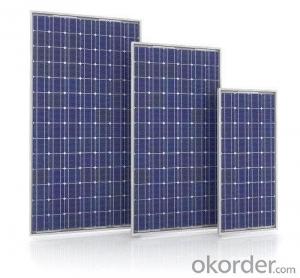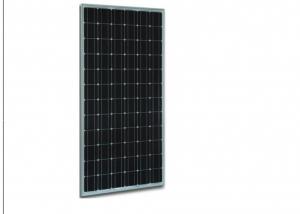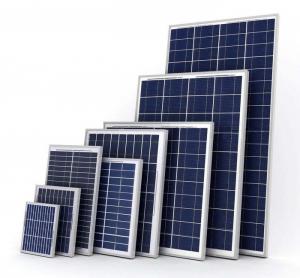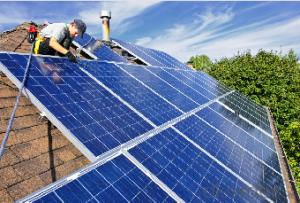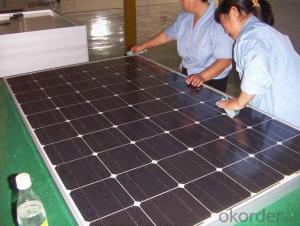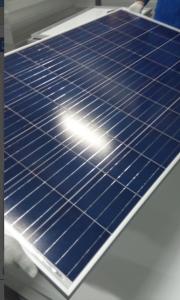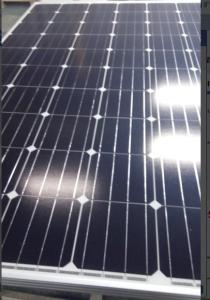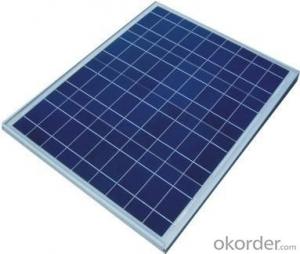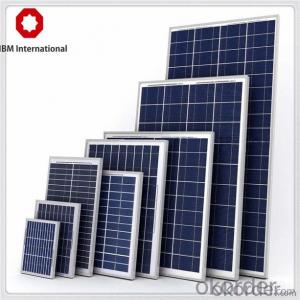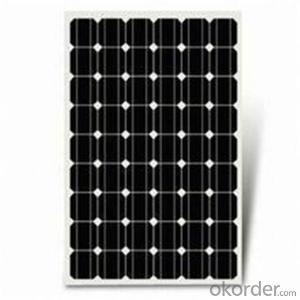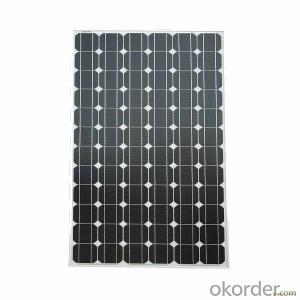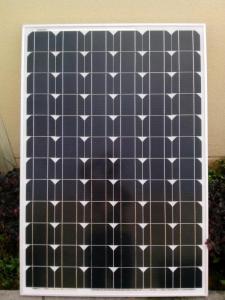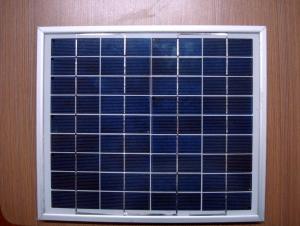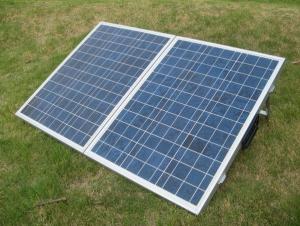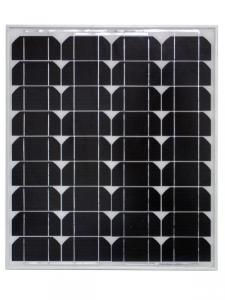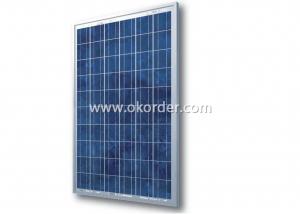250w Polycrystalline Solar Panels on Front of House - Made in Thailand
- Loading Port:
- China main port
- Payment Terms:
- TT OR LC
- Min Order Qty:
- 26 pc
- Supply Capability:
- 1000000 pc/month
OKorder Service Pledge
OKorder Financial Service
You Might Also Like
Characteristics of Solar Panel
I Solar Cell : High efficiency crystalline solar cell. Even if under the weak light, the solar module can produce maximum power output.
II Tempered glass (toughened glass): Anti-reflecting coating and high transmission rate glass increase the power output and mechanical strength of solar module.
III EVA and TPT: Using high quality EVA and TPT to prevent destroying and water
IV AI frame: Without screw, corner connection. 6 holes on the frame can be installed easily.
V Junction box: Multi function junction box with water proof.
VI Long lifetime: ≥25 years; Less power decrease.
VII Good performance of preventing from atrocious weather such as wind and hails.
VIII Resisting moisture and etching effectively, not effected by geology.
Currently,We have 250w-300w solar panel stocks in Both West and East Coasts made in Vietnam,India,Korea,Malaysia and Japan.Meanwhile,we also arrange production line in Wisconsin,USA.If you're interested,please contact us soon.
Thanks for your time.
- Q: Which is more efficient at producing energy? Reference(s) would be nice, but not required.
- Depends on the planet and solar panel. Generally, solar panels are more efficient according to these figures I bumped into. Photosynthetic efficiencies range from 0.% - 8%!
- Q: I don't have a regulator connected as they are a little expensive for a pensioner, If I join the panels into line to the battery bank from the roof should that be OK.?
- Two things on a regulator: a) It will optimize the charge to the batteries - and thereby distribute the most possible power to your active circuits during the day. b) It will prevent the power from the panels from boiling (no kidding) the batteries - no small thing as they are the second largest investment you have after the panels themselves. This is much more critical if you have sealed or Zero-Maintenance batteries. I strongly suggest that you get a regulator as it will significantly lengthen battery life. Follow the directions on the regulator for optimum input voltage and it will let you know whether all the panels should be in series, parallel or series/parallel. But cutting to the chase, you can certainly gang up panels as needed.
- Q: Can solar panels be used for powering electric fences?
- Yes, solar panels can be used to power electric fences. By harnessing the sun's energy, solar panels can generate electricity that can be stored in batteries and used to power electric fence systems. This renewable energy source offers a sustainable and cost-effective solution for powering electric fences in remote areas or locations without access to traditional power sources.
- Q: Can solar panels be installed on art installations or sculptures?
- Yes, solar panels can be installed on art installations or sculptures. In fact, integrating solar panels into art installations and sculptures has become a popular trend in recent years. This allows for the creation of sustainable and eco-friendly artworks that can generate renewable energy. Additionally, the combination of solar panels and art offers an innovative way to raise awareness about renewable energy and environmental issues.
- Q: Can solar panels be used in areas with high pollution or smog?
- Yes, solar panels can be used in areas with high pollution or smog. While pollution and smog may reduce the efficiency of solar panels to some extent, they can still generate electricity in such areas. However, it's important to regularly clean the panels to maintain optimal performance.
- Q: Around this time here in Georgia we will begin to get some big storms with high winds. I have a solar panel on a mount that isn't all that sturdy and could be knocked over with any winds pretty much above 5mph. I can't put anything in the ground to do this. I used to have it mounted to the roof of a playground for the most sunlight, but because of the angle of the sun and the tree leaves, I have to have it on a quot;portablemount so I can move it throughout the day, and I can tell you one thing is certain, and that's that it isn't the most sturdy thing ever. I'll have it a little better next weekend but it'll still be able to easily blow in the wind. Should I just hang the panel along the wall during a storm then reconnect it to its base once it's over?I'm pretty good with wood, so any wood creations to help out with the thing would greatly help. Just please keep it on a low budget.
- You have to make the decision weather you want it portable or stationary. If you want stationary I would make some good brackets for them / search for cheap ones on OKorder. I'd have to see them to be able to offer any better suggestions. It's always hard to decide so you'll have to take notes and do research.
- Q: i need someone to advice me which solar panels to buy.i have looked into few companies and i need some more info before decidingthe companies i checked were Sun tech trina solar Canadian solar and LDK solar.whice company should i pick?? please help.
- Selecting the right solar panels is like shopping for a car. Shop around and compare prices. Make sure the frame material will not rust or corrode away after a few years if you are near the ocean. Talk to satisfied customers is always wise. Get the guarantee in writing.
- Q: Can solar panels be used to power a hospital?
- Yes, solar panels can be used to power a hospital. Solar energy can be harnessed through solar panels to generate electricity that can be used to power various equipment and facilities within a hospital, including lighting, medical devices, ventilation systems, and more. Using solar power can help reduce reliance on traditional energy sources, lower operating costs, and contribute to a more sustainable and environmentally-friendly healthcare system.
- Q: a fiber optic network could distribute solar energy from warm states to the rest of the country. Using a Federally created program,the energy would be used through a trust program to benefit all of our citizens equally. It would create thousands of jobs and help us with our dependence on foriegn oil supplies. This is no different than work programs created by the Feds during the 930's depression era.
- This is a great idea, but there are some intrinsic difficulties with the theory: First, the average US household uses 27.4kWh of power per day= aprox. 0,000 kWh per year. Solar panels create kWh/m^2/day. Therefore you would need 27 m^2 (290 ft^2) of solar panels per household. Not only does that use a lot of space, but it would also cost a fortune. We also have to take into account that the government does not want us to become dependent of oil for many reasons. Therefore it is unlikely the government would ever consider paying for it. Lastly, for power grids to stay functional at all times, backup power plants must be kept 'hot', to replace solar power stations as they stop producing. There is an energy cost to keep plants 'hot', which includes (in the case of coal plants) the burning of coal. Unfortunately, if the country is not willing to accept brownouts, the carbon footprint of any large scale solar project will have to accept the 'hot' non-producing power plants carbon emissions as their own. The continued advances in the ability to store electricity will greatly impact the successful implementation of a large scale solar power station being, carbon footprint free. However, it would be possible for every household to have their own solar panels. Since they would need about 290 ft^2 (or 5ft x 5ft), then it does seem reasonable that they could have this much on their roof or land somewhere. Any additional energy you make from the solar panels you can sell back to the power plants and make money. They could then use this extra energy to cover in brown out situations, etc. In order for this to work though, we would all need to be responsible for purchasing and installing our own solar panels. It would be nice if the government would offer greater incentives to do so.
- Q: How do solar panels affect the roof's structural integrity?
- Solar panels do not typically affect the roof's structural integrity. Properly installed solar panels distribute the weight evenly across the roof and are designed to be lightweight. In fact, they can even offer some protection to the roof by shielding it from the elements. However, it is important to have a professional assess the roof's condition before installation to ensure it can support the added weight.
Send your message to us
250w Polycrystalline Solar Panels on Front of House - Made in Thailand
- Loading Port:
- China main port
- Payment Terms:
- TT OR LC
- Min Order Qty:
- 26 pc
- Supply Capability:
- 1000000 pc/month
OKorder Service Pledge
OKorder Financial Service
Similar products
Hot products
Hot Searches
Related keywords
